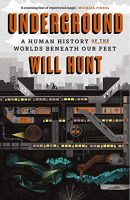Underground: A Human History of the Worlds Beneath Our Feet
By Will Hunt
Simon & Schuster (£16.99)
 When writers refuse to talk about their work — and talents as various as Harper Lee and Thomas Pynchon have exercised that prerogative — the usual advice is to attend ever more closely to the text. But what if the text isn’t printed on white paper and displayed on the screens of e-books? What if it’s sprayed on the walls of an underground railway, at places halfway between platforms, and to reach it you have to walk stretches of track that are known to graffiti artists as “blood and bones”…? Most of us would settle for a less thrilling read.
When writers refuse to talk about their work — and talents as various as Harper Lee and Thomas Pynchon have exercised that prerogative — the usual advice is to attend ever more closely to the text. But what if the text isn’t printed on white paper and displayed on the screens of e-books? What if it’s sprayed on the walls of an underground railway, at places halfway between platforms, and to reach it you have to walk stretches of track that are known to graffiti artists as “blood and bones”…? Most of us would settle for a less thrilling read.
Not Will Hunt. Over 10 years, beneath the streets of New York, he sought out the “pages” of a diary, written by a graffiti artist known only as REVS, on some 235 panels spread out over the network. Why, he wanted to know, would someone make an artwork in the darkest, most inaccessible part of the city, where almost no one could see it?
Underground is a questioning, questing book about all that goes unnoticed and unsung in the world beneath our feet. It takes the author to more than 20 countries; down into caves painted by Palaeolithic artists, into sewers and mines, tunnels and subterranean towns.
In Belize, half a mile below the jungle, he sees the bones of children whom the Maya sacrificed in the 9th century, in the desperate hope that the god of rain would end a drought. In Bolivia and Australia, he meets ochre miners whose dread of underground spirits is “mixed with an almost familial intimacy”. In Paris, he tramps catacombs that were long quarried for limestone, where “cataphiles”, in 2004, set up not only a cinema, with stone-carved seating for 20 people, but also a bar, lounge, workshop and dining room. When the police who stumbled on this set-up came back three days later for a proper look, they found an empty space, and a note saying: “Do not try to find us.”
Hunt, I reckon, would have seen that as a challenge. He has been drawn to the deep and the dark since he was 16 (he’s now 34), and began exploring an abandoned train tunnel near his childhood home in Providence, Rhode Island. I started his book knowing that Robert Macfarlane, who is perhaps Britain’s pre-eminent writer on place, is bringing out in May his own account of what lies beneath — Underland. I worried that the debut of a compulsive caver might be a poor lead-up to that. I needn’t have. Will Hunt is not just a compulsive caver; he’s a thoughtful, graceful and compelling writer. (So much so that I’m prepared to overlook that he didn’t contact someone in Australia but “reached out” to him.)
His book is only partly an account of his own obsession; his real interest lies in tracing the relationship that humankind as a whole has had with the underground, and he does so through mythology and history, art and anthropology, biology and neuroscience. He is fascinated by “the ways we are repelled by the dark, yet compelled by mysterious impulses to venture down into the earth”.
I can’t say I followed him unquestioningly from page one; reference points, vocabulary and spelling all put distance between us: “Find signs of it everywhere you go… the thrum of subway tunnels… vapor [sic] streaming out of a ventilation grate.” But thereafter I was right behind him as he went down every ladder and rope, squeezing eagerly through places that would normally bring on claustrophobia.
“Over hundreds of thousands of years,” he writes, “our vivid and perplexing connection to the underground has not diminished — and it never will. We will always feel a quiet glow emanating from the world’s buried places; it may be forbidding or enchanting, but we will never look away.” We won’t, anyway, when we have guides like him to enlighten us.
His book is deeply researched, in more ways than one (though minus a bibliography), but sparely written and a joy to read. Indeed — and I don’t often find myself saying this of books originating in the United States — I would happily have read more. Underground runs for 267 pages, plus acknowledgements and credits, with nearly 80 pictures/ illustrations in black-and-white. It’s in a type size that suggests the publishers, too, might have been expecting a longer book. Or maybe they’ve just designed it to be read in the dim light of tunnels… MK
This review appeared in The Daily Telegraph on March 9, 2019
